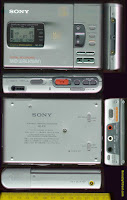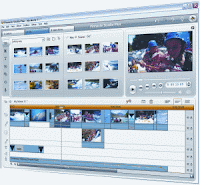About ten years ago, you could have found me sitting behind the sound desk at the back of a church, where recordings of services were made available on tapes for those housebound (or just unable to make it out that morning).
Getting a decent master tape to duplicate was a bit of an art. No point including three minutes of ambient coughing while the collection is taken, or the entire minute of banging and shuffling while the kids go out to Junior Church half way through the service. So a bit of careful pausing and (when remembered) un-pausing.
The end of side 1 of the C95 cassettes we used always seemed to coincide with some crucial bit of the sermon (as opposed to a throw away line) and if you misjudged the little dance of hitting Stop-Eject-turn the tape-Rec-Play - there was no auto-reverse button on the deck! - you could lose the main point and make a nonsense of the whole thing.

So I tended to record the whole service onto a MiniDisc as backup.
I came across my original MD MZ-R30 player recently while tidying up the study - and it started the train of thought behind this post.
The MD capture was great, as the MZ-R30 could automatically break the recording into tracks as it went along. Two seconds or more of silence and it would make a new track. So it was pretty fast to skip through the service afterwards, and a piece of cake to label (or title) some of the tracks to mark the start of songs and sections of the service to make mid-edit navigation even faster.
Splitting tracks with too much trailing/leading silence was simple, and then deleting the unwanted gaps. And easy to chose a suitable sentence to end side 1 and turn the tape.
The only downside of a week when I had to revert to using the MD backup was having to go back and re-record the master tape from it in real time to go off for duplication.
Now whether a church service, a podcast or a radio show, editing in chunks is what you want. Self-contained packages of content that can be moved around, cropped, shortened and if necessary reordered.
So why is it that tools like Audacity (and I think Garageband - though I've less experience and could be wrong) make editing audio so cumbersome? Insisting on (or defaulting to) a single loooong track of sound, navigation is lousy, labelling is difficult, and everything seems to take five times as long as it did on a handheld MD recorder ten years ago.

Surely the storyboard metaphor used in video editing software is what audio editors need too? Something to compartmentalise content and decompose it into more manageable chunks? And then once the smaller pieces are refined, and sound effects added in the appropriate places, the timeline can be brought back for final finishing?
Maybe I've got it all wrong and am missing the features and usability of the audio tools? If so, I'm sure you'll not be slow to correct and enlighten me! Or maybe you'll agree that when it comes to editing audio that lasts longer than 10 minutes, we're poorly served by the software available.
1 comment:
ACK - I still occasionally end up having to take our service CD and remastering. I use Audacity, and it's a real pain to join tracks (IIRC, splitting a track into two separate tracks is simple enough).
The other thing that Audacity lacks (sure Garageband doesn't) is the "write to CD" capability - so you end up having to save a bunch of MP3s, importing them into iTunes / WMP, and *then* making a CD. Serious hassle that just isn't there when dealing with Vid.
Sounds like a masterclass for Tech Camp needed :)
Post a Comment